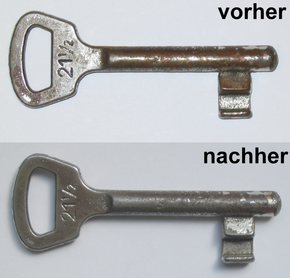Rust converter
Rust converters are liquid mixtures of substances for the chemical conversion of rust (FeOOH or iron (III) oxide ) into e.g. B. stable iron (III) compounds.
Rust occurs when either oxygen in a moist environment or an acid reacts with iron. Rust layers are porous, so that oxygen can get through them to the still undamaged iron. As thicker layers of rust absorb moisture and delay drying, the formation of new rust accelerates if the initial rust layer is not removed.
In contrast to iron, other metals such as tin, zinc, copper and aluminum form very dense oxide layers on the surface, under which no further oxidation takes place. In the anodizing process , the surface of aluminum is passivated in this way .
Rust converters are used in the repair of cars, construction machinery, ships, fences, etc. Thorough protection can usually only be achieved if loose rust is first removed, e.g. B. by brushing, grinding or sandblasting. Rust converters cannot convert the rust back into metal, treated surfaces do not become shiny again, but dull dark gray to black.
Active ingredients
Today, rust converters contain almost all phosphoric acid or phosphates as an effective component. When used, iron (III) oxide is converted into water and iron (III) phosphate . The iron phosphate layer is not porous like rust (a mixture of different iron oxides), but solid and can be painted over.
Individual products work on the basis of tannins . In the past, heavy metal oxides such as lead ( red lead ) and cadmium and chromates were used . With these stable iron oxides are formed, in the case of tannin also water-soluble iron-tannin compounds. Heavy metal compounds, however, are often toxic and harmful to the environment .
In addition to the actual active ingredient, rust converters often contain various auxiliaries and additives to support the rust converting process. Surfactants , for example , are used, which ensure better wetting of the surface of the workpiece to be treated. Other auxiliaries serve as reaction accelerators or fat dissolvers and as thickeners. Often, commercially available rust converters are mixed with primers or directly with a top coat .
Also Cola contains phosphoric acid. Because of the low acid content, however, the effect is small.
Many acids are suitable for dissolving rust. In contrast to phosphoric acid, however, there are usually no adhering reaction products that prevent further rust formation and are suitable as a substrate for building up further layers of paint. The surface must therefore be cleaned mechanically after use. When using oxalic acid, a coating of poorly soluble iron (II) oxalates forms , which prevents renewed rust formation.
The problem with the use of rust converters is that the reaction of rust and acid takes place stoichiometrically . To get a predictable result, rust and acid must be brought together in a certain ratio. Different reaction products can be formed depending on the local proportions.
If you work with an excess of acid, it is often recommended to wash off the remaining acid after the reaction or to neutralize it with a weak alkali (e.g. soapy water).
See also
Individual evidence
- ↑ a b Entry on rust converter. In: Römpp Online . Georg Thieme Verlag, accessed on June 7, 2014.
- ↑ a b Brockhaus ABC chemistry . tape 2 . VEB FA Brockhaus Verlag, Leipzig 1965, p. 1215 .
- ↑ Dagmar Wiechoczek: Oxalic acid for bleaching, stain removal and rust removal , Prof. Blum's educational server for chemistry, June 20, 2007
- ↑ Rust removal with oxalic acid , Hausjournal.net
- ↑ Information collection: Chemical rust removal ( Memento of the original from October 25, 2017 in the Internet Archive ) Information: The archive link was inserted automatically and has not yet been checked. Please check the original and archive link according to the instructions and then remove this notice. , Rostschutzforum www.rostschutz-forum.de

